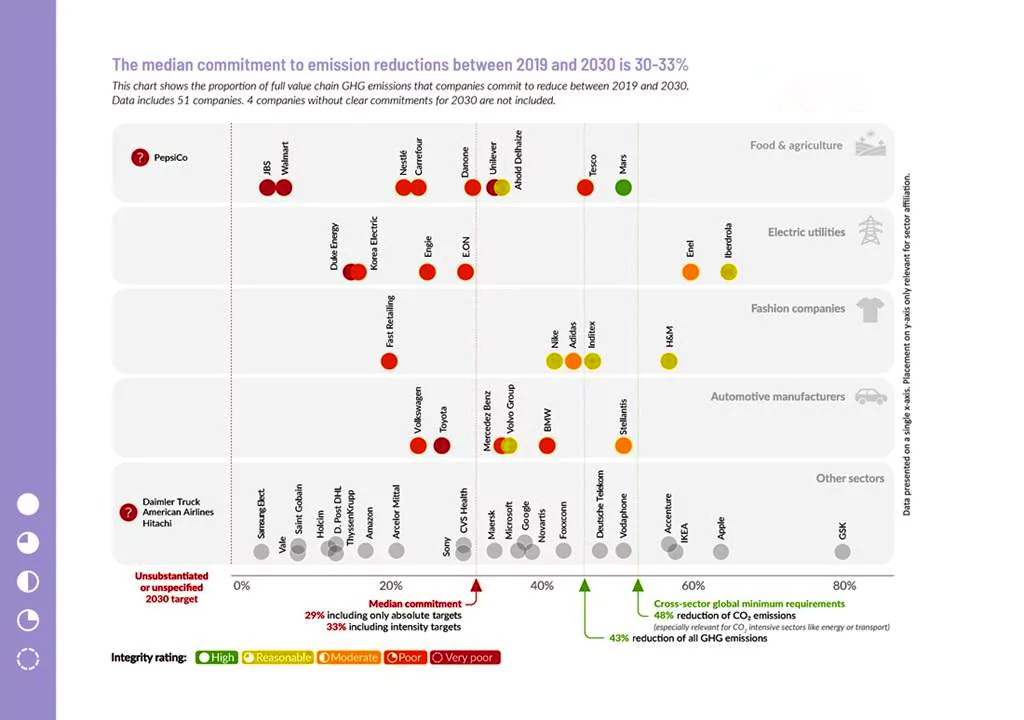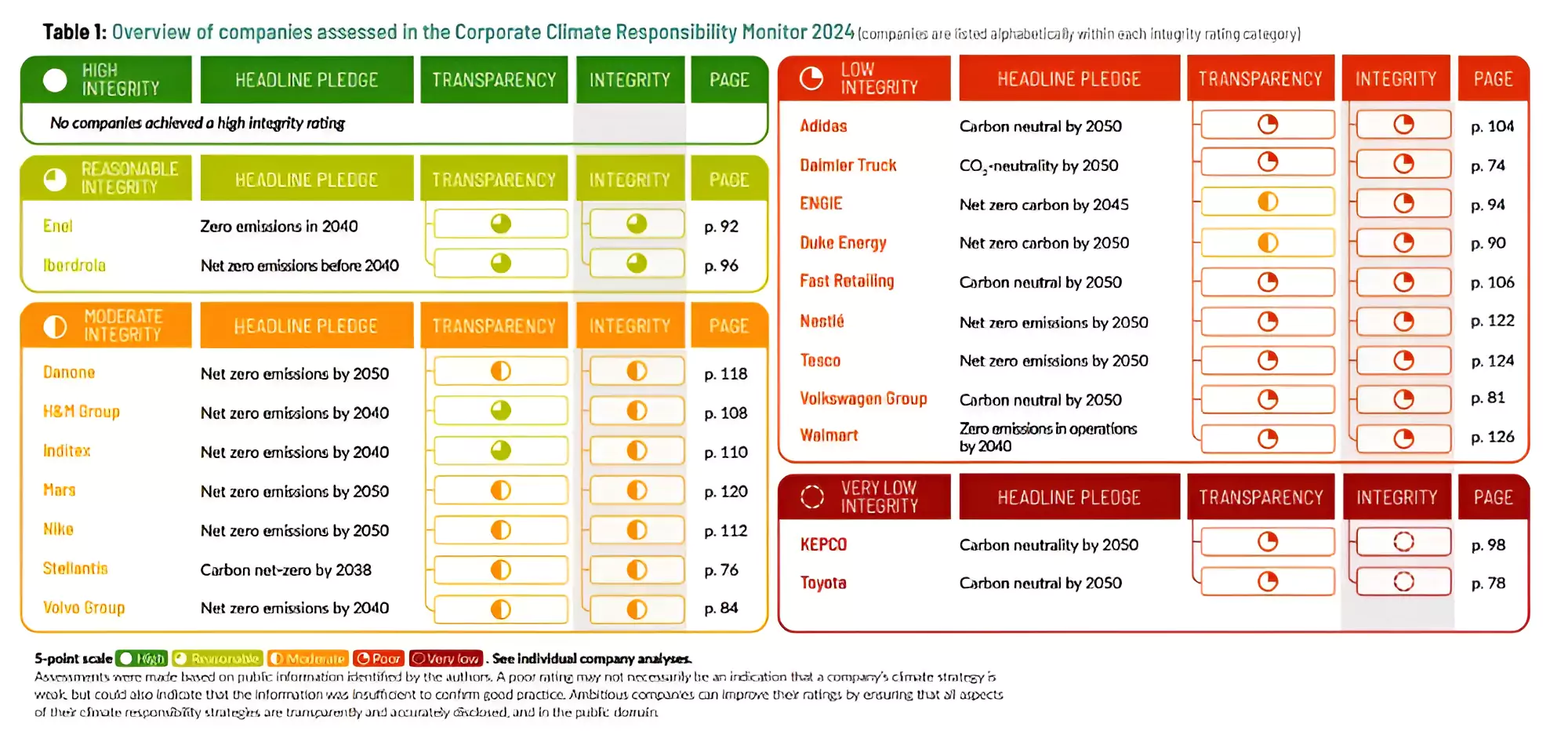Context
Recently, The Corporate Climate Responsibility Monitor 2024 report was released by the non-profit New Climate Institute with assistance from Carbon Market Watch.
Corporate Climate Responsibility Monitor Report 2024
- The report evaluated climate targets of 51 major corporate companies worldwide.
- These companies collectively generated $6.1 trillion revenue in 2022 and reported emitting 8.8 gigatonnes of CO2 equivalent, roughly equal to India, Russia, and Brazil combined.
- This accounts for approximately 16% of global greenhouse gas emissions in 2022.
Enroll now for UPSC Online Course
About Corporate Climate Responsibility Monitor (CCRM)
- CCRM stands for Corporate Climate Responsibility Monitor (CCRM).
- It assigns Integrity scores ranging from “High” to “Very Poor” on a 5-point scale based on this evaluation.
-
Key Areas of Corporate Climate Action:
-
- Emissions Tracking and Disclosure: This involves monitoring and revealing emissions data.
- Setting Emission Reduction Targets: Companies establish goals to reduce carbon emissions.
- Reducing Own Emissions: Actions are taken to decrease a company’s own emissions.
- Addressing Unabated and Residual Emissions: Efforts are made to manage and take responsibility for emissions that cannot be eliminated.
Key findings From the Corporate Climate Responsibility Monitor Report

-
Emission Reduction Targets Fall Short:
- 30% emission by 2030: The 51 largest companies assessed by CCRM are only on track to reduce emissions by 30% by 2030, relative to 2019 levels.
- 50% emission by 2030:Only 7 out of 51 companies have targets that aim for a reduction of more than 50% by 2030.
-
Corporate Companies Performance in Emission Reduction Plans:
-
- The CCRM’s Integrity Score shows no company achieving the highest level of transparency and accountability for meeting their targets.
- Danone, Iberdrola, Mars, and Volvo Group demonstrate stronger plans compared to others.
- H&M, Nike, and Inditex have plans but it is inadequate to achieve their targets.
- Walmart hasn’t updated targets since 2016, and Volkswagen dropped its interim 2025 target without a replacement.

-
Challenges in Meeting Climate Targets:
- Controversial Solutions: The report reveals that many countries rely on controversial methods to meet their targets, such as carbon capture, transitional fuels, and bioenergy.
- Slow Progress: While companies are making gradual progress on their climate goals, they are falling short of achieving the necessary emissions reduction to limit global temperature rise to 1.5 degrees Celsius.
- Risk of Accountability Evasion: There’s a danger that companies might avoid responsibility by using carbon offsets.
- A proposed framework for offsetting Scope 3 emissions could exacerbate this issue.
-
Risk of Offsets Loophole:
- The report identifies a potential loophole in carbon offsetting methodologies that could weaken accountability for Scope 3 emissions (those from the supply chain).
- The offsets loophole
Carbon offsetting
- It refers to decrease in GHG emissions or rise in storage of carbon (by land restoration or plantation of trees).
- These are used to balance the emissions.
|
-
-
- Scope 1 Emissions: These come from a company’s direct activities, like its own production processes, causing emissions.
 Scope 2 Emissions: This relates to a company’s energy usage, such as the electricity it consumes.
Scope 2 Emissions: This relates to a company’s energy usage, such as the electricity it consumes.- Scope 3 Emissions: These stem from sources outside a company’s direct control, like emissions produced when customers use its products.
- Importance of Scope 3: Scope 3 emissions make up most emissions across various industries.
-
Proposed Changes in Carbon Offsetting:
- VCMI Proposal: VCMI introduced a “beta Scope 3 Flexibility Claim,” allowing companies to offset up to 50% of their Scope 3 emissions.
- Acceptance by SBTi: SBTi, a major validator of corporate targets, agreed to consider carbon offsetting as a means to address Scope 3 emissions.
- However, it is unclear if the VCMI proposal will be linked to SBTi.
Impact of Flexible Offsetting
- Reduced Accountability:
- Proposals like VCMI’s “beta Scope 3 Flexibility Claim” and SBTI’s acceptance of offsets for Scope 3 emissions could weaken accountability for companies.
- Companies might prioritize offsetting over actual emission reductions in their supply chains.
- Downgrading of Ratings: This move would lower companies’ ratings to “Poor” due to the significant role of Scope 3 emissions in their value chains.
- Insufficient Targets: The report noted that existing Scope 3 emission targets are insufficient to align with a 1.5°C pathway.
|
Enroll now for UPSC Online Classes
-
Over reliance on Voluntary Reporting:
- Voluntary Nature: Climate targets set by corporate companies are voluntary and assessed by standard-setting bodies to determine their robustness.
- Validation Frameworks: Bodies like SBTi, Transition Pathways Initiative, and MSCI Net Zero Tracker validate these targets, lending legitimacy to company goals.
- Shortcomings of the System: While over 1,000 companies have outlined emission reduction plans under this voluntary system, there are gaps in progressing towards these targets and ensuring accountability.
Also Read: Emissions Gap Report 2023
![]() 13 Apr 2024
13 Apr 2024


 Scope 2 Emissions: This relates to a company’s energy usage, such as the electricity it consumes.
Scope 2 Emissions: This relates to a company’s energy usage, such as the electricity it consumes.